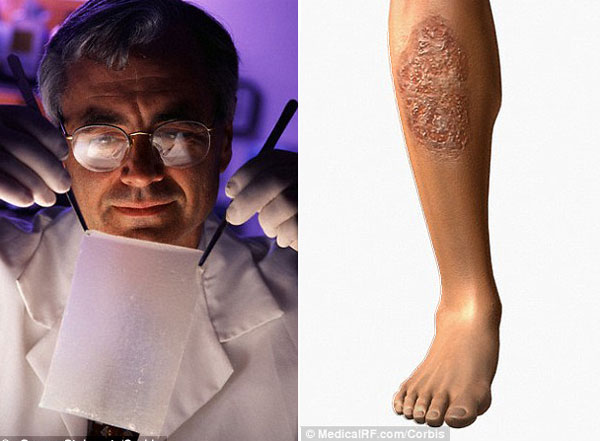Detecting dead skin helps to heal wounds faster
Researchers at the university. Manchester (UK) recently announced a quite useful finding for the medical community when it found a basis for putting dead skin into the treatment of skin wounds for patients.
According to researchers, the skin taken from the dead may soon be applied to the treatment of external wounds for patients in the future. This conclusion comes from a rather intensive study with more than 50 healthy volunteers supporting.
Researchers found that the skin from the corpse was quite effective in healing acute wounds such as burns or ulcers. This application is hoped by researchers to be able to open a new direction for medicine, besides contributing to reducing medical costs for countries. In the United States alone, the cost of treating skin wounds is usually very large every year, up to 25 billion USD / year.
For decades, scientists have constantly researched and developed effective forms of skin replacement to help treat skin wounds. These alternative skin types are almost entirely made to resemble maximum protein extracellular matrix (membrane outside the cell due to proteins and bonding compounds).

However, often the methods mentioned above are very expensive and not yet popular. That's why a research team led by Ardeshir Bayat, a biology engineer from the university. Manchester (UK) came up with the idea of using corpse skin to apply on people. By the researchers, the skin of the corpse will be able to clean up antibiotics.
The researchers used a combination of detergents, enzymes and many other chemicals to remove cells from the skin. Therefore, the recipient's immune system will be less likely to respond to non-reception of the organ from the outside. At the same time, the team also said that they have peeled off the inner layer of the skin, which is the dermis, which contains strong blood, nerves, hair follicles and sweat glands and leaves the extracellular matrix. the protein.
Dr. Bayat likens this skin to a hollow house with no interior so we can easily assemble and recreate a house like the original. In the same way, the dermis will provide an important layer of support for the body's cells. At the same time, the research team also discovered that this dermis can also treat very well for acute wounds such as burns.
In the study, the scientists took out four skin plates, each about 5mm from 50 healthy volunteers. All of them will then be tested on pre-prepared wounds. A wound will be left to heal naturally, another wound will use the skin has been removed to reattach, the third wound uses artificial skin and the last wound uses the skin taken from a fatal exam.
The research progressed and scientists found that the skin from the corpse was well adapted to the volunteers' bodies and they brought about an impressive stimulation of new blood vessels under the skin. In particular, it can regenerate the skin in the scars.

Judging by the advantages of this particular skin layer, the researchers found that it offers many advantages over artificial skin pretty much because they are more familiar and suitable for the human body.
Dr. Bayat is currently planning to test this skin layer on real patients as well as adding a stimulating current to explore the ability to accelerate skin regeneration.
Reportedly, his research team once demonstrated that dead skin can treat chronic wounds that last 6-8 weeks or in some cases up to 1 year. Even Dr. Bayat recounted, he and his colleagues had also cured a 92-year-old patient and had more than 20 years of living with skin ulcers. Surprisingly, however, after this 4-week treatment using this special cadaveric skin, this patient was completely healed.
This study once again opens a new joy for the majority of the elderly population today, as the aging population is rapidly increasing and the proportion of people suffering from skin wounds Due to diabetes or obesity is also increasing. Hopefully this positive research will soon achieve further progress to quickly be widely applied in the near future to open up opportunities to treat skin wounds for everyone.
- New findings: Your wounds heal faster in the daytime than at night
- Ointments made from maggots help wounds heal faster?
- Why does your wound heal?
- Cell technology breakthrough helps heal large wounds on the skin
- Cod skin can heal wounds
- The patch helps to heal wounds
- Detection of bacteria helps wounds heal
- Artificial skin from microalgae, provides oxygen to help wounds heal
- Scientists found that the gene can heal itself
- New artificial skin
- America develops super chips that help heal wounds
- Dead skin helps clean the air
 Green tea cleans teeth better than mouthwash?
Green tea cleans teeth better than mouthwash? Death kiss: This is why you should not let anyone kiss your baby's lips
Death kiss: This is why you should not let anyone kiss your baby's lips What is salmonellosis?
What is salmonellosis? Caution should be exercised when using aloe vera through eating and drinking
Caution should be exercised when using aloe vera through eating and drinking Why does ice stick to your hands when you hold it?
Why does ice stick to your hands when you hold it?  Doctors warn about the 'secret' of soaking your face in ice water to stay young
Doctors warn about the 'secret' of soaking your face in ice water to stay young  'Unexpected' source of nutrients from the peels of many vegetables and fruits
'Unexpected' source of nutrients from the peels of many vegetables and fruits  From 'monster' to 'treasure': This horror species is helping many people make a fortune
From 'monster' to 'treasure': This horror species is helping many people make a fortune  How are freckles different from melasma?
How are freckles different from melasma?  Discovery of dinosaur fossils with feathers and scales
Discovery of dinosaur fossils with feathers and scales 